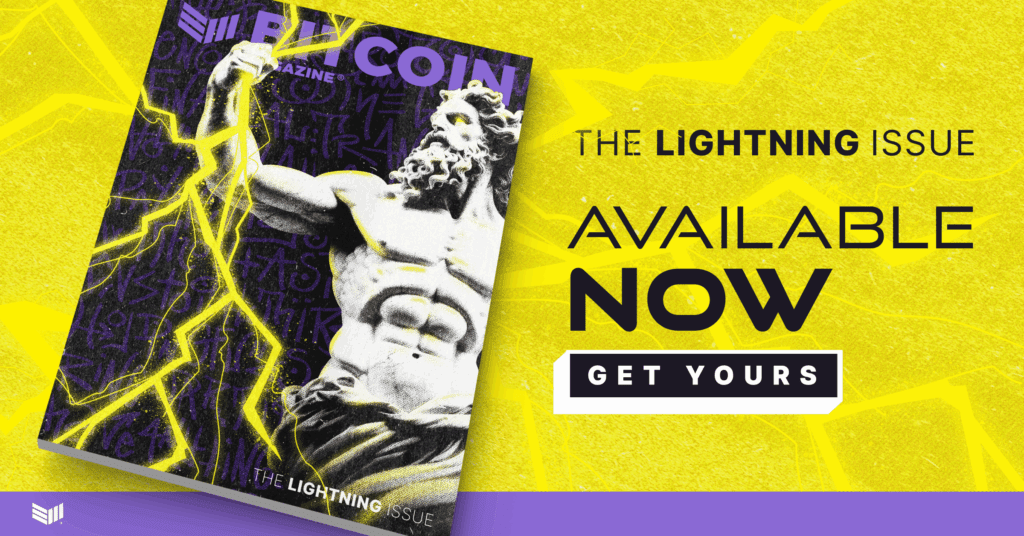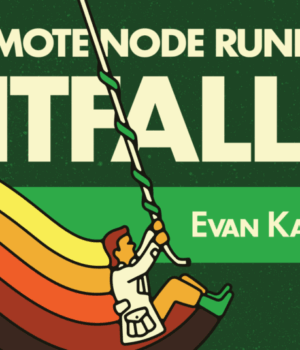For node runners, setting up a remote Lightning node to send and receive your own payments has never been easier. Thanks to modern wallets and managed platforms, getting up and running can be low friction, secure and even enjoyable. But the moment you decide to take on the role of routing payments for others — hoping to earn satoshis from fees — the game changes completely.
The Hidden Pitfalls of Running a Remote Lightning Node
Running a remote Lightning node can be a powerful way to participate in the Bitcoin ecosystem. For the technically inclined, it offers not only a hands-on way to interact with the Lightning Network but also the possibility of earning satoshis by routing payments. However, while the rewards are real, so are the risks — and the learning curve can be steep. Operating a Lightning node remotely introduces a host of subtle (and not-so-subtle) pitfalls that can jeopardize your uptime, your reputation in the network, and potentially even your funds.
Even if you’re just running a remote node for personal payments, it’s still important to understand how things like backups, channel quality, and remote access can impact your experience.
Let’s explore the common pitfalls of remote node operation for both the low-stakes plebs who just want to make payments and the high-stakes ones — those operating routing nodes.


Payments vs. Routing: Choose Your Role
Running a Lightning node to make your own payments is very different from running one to route payments for others. The former can be achieved with minimal setup and a few strategic channels. The latter demands constant attention, capital deployment, and a firm grasp of fee markets and liquidity dynamics.
Problems arise when node operators try to do both without understanding the trade-offs. Sending payments requires outbound liquidity. Routing payments often depends on maintaining balanced channels with high uptime and connectivity. And yet, too often, node runners configure their nodes to serve neither purpose well. They set routing fees too low to be sustainable or too high to be competitive; as a result, their nodes end up doing nothing at all.
Recommendations: Decide what you want to achieve from the onset and optimize your node accordingly. Sure, you can try to do both but know that becoming a successful router will be much more time-consuming and require more capital.
Don’t Cheap Out On Node Runner Hardware
The hardware behind your Lightning node might not seem like a big deal — after all, it’s just running software, right? But in reality, the demands are higher than many newcomers expect. Lightweight cloud instances or single-board computers like the Raspberry Pi may work fine for basic usage, but they’re far from ideal for a remote, 24/7 routing node.
Unreliable VPS (virtual private server) providers and sudden server shutdowns can result in corrupted databases or channel closures. If the underlying disk performance is poor, your node may lag behind the blockchain or crash unexpectedly. Most dangerously, if your node goes offline without a recent backup, your channels could be force closed in an outdated state, risking real financial loss.
High-availability setups with sufficient memory, fast SSD storage, and reliable backups are not optional — they’re the foundation of a robust remote node.
Recommendations: If not going with a VPS, get something beefier than a Pi with an AMD or Intel chip and at least 8GB of RAM.
Surge protectors aren’t enough: Get yourself a UPS (uninterruptible power supply) for your node and a router for optimal uptime. Consider setting up a second disk drive as a clone in case the first one gets corrupted, or at the very least, set up email backups of your channel state.
If looking for a pre-built node solution, Start9 makes some great devices. MyNode and Umbrel are solid choices as well.
Software: Get Your Stack Right
Once the hardware is in place, the software stack comes into focus. Lightning clients like LND, Core Lightning, and Eclair each have different functionality. Some have more robust APIs than others, some have features that others don’t (e.g., BOLT12, hop picking, coin control). Worse still, each has its quirk, and selecting the wrong tool for your use case can cause friction down the line.
Many node runners overlook automation entirely. Without systems in place for regular backups, channel monitoring, liquidity rebalancing, or fee updates, your node may work fine — until the day it doesn’t. Equally problematic is a lack of observability. If you’re not tracking your node’s performance using tools like ZEUS, Thunderhub, or Prometheus-based monitoring, you may not realize something is wrong until it’s too late.
For the less technical, bundled node platforms like StartOS and Umbrel could make for good options, but the software available on them (and their functionality) vary wildly.
Recommendations: Do some research into what functionality you’re looking for from your Lightning node and select your client and platforms accordingly. If you don’t have the technical ability to spin up everything manually, don’t overextend yourself; there are great projects like RaspiBolt that can walk you through all the steps if you’re interested.
Lastly, check to see if software is actively maintained before relying on it too heavily. Unmaintained software may also have security vulnerabilities.
Security: Hot, Online, and Vulnerable
By far the most critical and least forgiving pitfall is security. Lightning nodes, by design, require hot wallets. This means your funds are available on an internet-connected machine, potentially accessible by malicious actors if proper safeguards aren’t in place.
Unfortunately, most node operators don’t implement strong operational hygiene. Backups are often skipped or poorly stored. Login credentials are reused or poorly managed. Firewall rules are lax. And when disaster strikes — whether it’s a server wipe, accidental deletion, or a compromised key — the result can be permanent loss.
Security isn’t just about avoiding theft. It’s also about ensuring continuity. A secure, well-backed-up node can recover from a crash or migration. An insecure one can lose everything.
Recommendations: If you don’t know what you’re doing, don’t mess with the default system or networking settings or roll out your own security, and definitely don’t open up ports on your router.
Do be mindful of what services you expose to the internet, and use unique, secure passwords everywhere. Password managers are a necessity in today’s day and age.
Backups, Backups, Backups
If there’s one mantra that every remote Lightning node operator should repeat daily, it’s this: backups, backups, backups. Unlike traditional Bitcoin wallets, which can often be recovered with a single seed phrase, Lightning nodes require a more nuanced and fragile recovery process. If you lose your node state, you don’t just lose access — you risk losing funds.
The most critical piece is your channel database, which tracks the current state of all open channels. If this becomes outdated or corrupted and your node reconnects to the network, your peers may see a discrepancy and force close the channels. In the worst-case scenario, if the backup is too old, the network will assume you’re trying to cheat — and penalize you by seizing your funds. Yes, you can be punished for recovering improperly.
To mitigate this, most Lightning clients support static channel backups (SCBs) — snapshots of your channel structure that allow for a safe recovery via cooperative close. While SCBs won’t let you recover your exact balances immediately, they at least prevent the loss of funds by enabling channels to be closed in a safe state.
However, SCBs aren’t automatic unless you configure them to be. Too many node runners forget to export and store them regularly. And even when they do, they often store backups on the same machine, or worse, the same drive. When that server goes down, so does the backup.
Recommendations: Make sure you have a rock-solid backup strategy. If you don’t have a duplicate drive, at least set up a process to email your SCBs to yourself (they’re encrypted with your seed by default, so err more on availability than privacy when it comes to them).
Consider having your backups in multiple locations and periodically conduct tests to restore them — even when you don’t have to — to make sure everything is in place and working. This applies to your cold storage Bitcoin keys, passwords, and general file backups. You don’t want to be stressed and unsure of your setup when you are forced to do a recovery.
Remote Connection: The Weakest Link
If you’re using your remote node for payments, you obviously want to be able to access it on the go. By default, the prebuilt node platforms give you remote access to your node via Tor, but Tor is notorious for being slow and unreliable.
Thankfully, there are a bunch of alternatives for remote connections, including Tailscale, Nostr Wallet Connect (NWC), Lightning Node Connect (LNC) [LND only], and private VPN connections.
Recommendations: Don’t be the guy holding up the line by fiddling with their Tor connection. Most remote node wallets allow you to switch between multiple connections, so consider having some alternative connection methods to fall back on.
I maintain ZEUS so that’s my clear recommendation for a remote mobile wallet, but the folks over at BitBanana (Android) make a fine free and open source app as well.
Lastly, if you’re running a big routing node, it’s not smart to connect to the main wallet in public. You really should only have accessible what you’re comfortable with carrying in your fiat wallet. Consider either setting up a subaccount with NWC or LNC. Alternatively, just set up a mobile wallet and connect a channel to it from your routing node. Both of these methods work with ZEUS.
Channels: Not Set-and-Forget
If Lightning is a road network, then channels are the lanes. And like real roads, they need to be built well and maintained regularly. Many new node runners open channels at random, without assessing peer reliability, capacity, or connectivity. As a result, their channels either sit idle or become dysfunctional due to unbalanced liquidity.
It’s also easy to fall into the trap of overextension. Eager to be a “routing node,” some users open too many channels too quickly, burning through funds and transaction fees while diluting their ability to manage liquidity effectively. Without tools or practices for assessing channel health and performance, even a well-funded node can struggle to route a single sat.
Recommendations: Start slow if you’re a routing node and don’t just deploy a bunch of capital haphazardly until you understand all the nuances. As you become a bigger node, you may want to consider setting up a channel acceptor to prevent smaller nodes from opening channels to you at random and adding operational complexity.
If you’re going down the routing path, look into LNDg (LND only) or CLBOSS (Core Lightning only), both of which are incredibly useful for automated channel rebalancing. Balancing protocols like Peerswap, and swap services like Loop (LND only), Boltz.exchange, and ZEUS Swaps can also be powerful tools to consider.
If you’re not looking to be as hands-on with your channel management, there’s nothing wrong with getting your first channels from a Lightning service provider (LSP) to ensure you can send and receive payments reliably.
Final Thoughts: Tread Carefully, Build Confidently
Operating a Lightning node remotely can be incredibly rewarding — but only if approached with the same seriousness you’d apply to running a financial service. Because in many ways, that’s exactly what it is. The Lightning Network is still growing and maturing. While its promise of instant, low-cost, global payments is very real, the infrastructure behind it is still nascent.
If you’re setting up a node just to pay over Lightning or receive some sats, modern wallets and platforms make that easier than ever. For users in this category, most of the headaches described in this article won’t apply.
But if you’re trying to run a profitable routing node — or even just a performant one — you need to treat uptime, liquidity, security, and observability as nonnegotiables. There are no shortcuts. It’s not set-it-and-forget-it. It’s a living system that demands your attention.
For those who do invest the time and care to do it right, however, the rewards go far beyond routing fees. You gain a front-row seat to the future of Bitcoin — and help shape it.

Don’t miss your chance to own The Lightning Issue — featuring an exclusive interview with Lightning co-creator Tadge Dryja. It dives deep into Bitcoin’s most powerful scaling layer. Limited run. Only available while supplies last.
This piece is an article featured in the latest Print edition of Bitcoin Magazine, The Lightning Issue. We’re sharing it here to show the ideas explored throughout the full issue.









